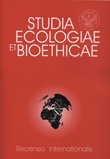Assessment of physiological status of felids as an indicator of their welfare in the wild
Assessment of physiological status of felids as an indicator of their welfare in the wild
Author(s): Ekaterina Pavlova, Evgeny Ivanov, Vadim Kirluk, Vyacheslav V. Rozhnov, Sergey NaidenkoSubject(s): Geography, Regional studies
Published by: Wydawnictwo Naukowe Uniwersytetu Kardynała Stefana Wyszyńskiego w Warszawie
Keywords: stress; hematology; serology; welfare; wild cats; Panthera pardus orientalis; Otocolobus manul; Panthera tigris altaica
Summary/Abstract: One of the main approaches to monitoring the welfare of wild mammal populations in the wild is animal health estimation based on an analysis of their physiological parameters. To assess that for the natural felid populations, we analyzed adrenal activity level, white blood cells (WBC) counts and occurrence of seropositive reactions to different diseases. The first study was conducted in the Southwest Primorye, in natural habitats of Far Eastern leopard. Unevenly cold and snowy winters in 2010 and 2011 provided extreme natural conditions for overwintering mammals across the Russian Far East. Adrenocortical activity of leopards was significantly higher in 2011 (fecal cortisol level was 712.7 ± 92.4 ng g-1) than in 2010 (361.4 ± 80.5 ng g-1). We suggest that abundance and availability of weakened deer and carcasses could facilitate hunting for leopards and help them to avoid starvation. In the second study we used WBC counts as a health index for three felid species: Pallas cat (Daursky State Nature Biosphere Reserve, 2010), Far Eastern leopard (Southwestern Prymorie, 2011), Siberian tiger (Ussuriskii Reserve, 2010-2011). The ratio of neutrophils to lymphocytes (N:L) was used as an indicator of stress and/or disease state. Occurrence of seropositive reactions to 12 different pathogens was analyzed in all the animals after the hematological analysis. Pallas cats had the lowest N:L ratio (1.0 ± 0.1), significantly differing from leopards (42.8 ± 16.0) and tigers (24.5 ± 9.2). The N:L ratio correlated with the occurrence of seropositive reactions but not with the pathogen diversity. Pallas cats had the lowest occurrence of positive reactions to 4 pathogens: Toxoplasma gondii (12.5%), Mycoplasma sp. (12.5%), influenza A (7.1%), and feline leukemia virus (8.3%). Leopards had the highest N:L and occurrence of seropositive reactions only to 2 infections: T. gondii (16.6%) and Candida sp. (100%). On the contrary, tigers had positive responses to 6 pathogens, including canine distemper (7.7%), feline immunodeficiency virus (8.3%) and Aujeszky's disease (31%), which were not found in other cats. Values of N:L depended also on the time spent to get blood samples. In the big felid species effects of glucocorticoids on the WBC ratio (neutrophilia) were obtained in blood samples from anesthetized animals, taken more than 2 hours after capture. In Pallas cats blood samples were collected within 13 ± 2 min without anesthesia. Thus the high N:L ratio in big felids can be explained by several reasons: stress of capture, immunosuppression and a high diversity of detected infections. The present findings may have important implications for creation of effective conservation strategies of rare felid species in the wild.
Journal: Studia Ecologiae et Bioethicae
- Issue Year: 13/2015
- Issue No: 1
- Page Range: 107-122
- Page Count: 16
- Language: English

